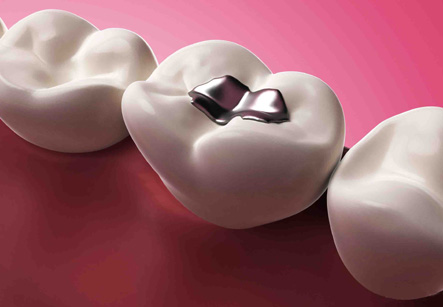Amalgam Filling
Introduction
Amalgam fillings or silver fillings are a mixture of different metals containing 65% silver, 6% copper, 2% zinc and 25% tin bound with elemental mercury. These alloys are mixed with mercury by a process called as trituration. The mercury makes up between 50% of the mixture and acts as sticking agent that binds these metals into a hard, stable, and safe substance lasting for decades. These fillings usually last for a period of 12 years or longer.
Amalgam filling material is relatively inexpensive than other fillings.
There is an increased risk of tooth fracture in teeth with large amalgam fillings. Large (silver mercury) fillings can let the tooth bend beyond a critical breaking point and fracture. Also, the higher the biting stress on the tooth (like in back teeth), the higher the risk of breaking. Therefore, the large old silver mercury fillings should be protected by crowning the teeth before the fracture occurs.
Before the procedure:
The dentist and the patient should discuss about various types of fillings, their pros and cons as well as suitability of amalgam filling for the patient. Then, the procedure should be explained to the patient.
Amalgam filling material is relatively inexpensive than other fillings

Procedure
1. If the dental cavity is large which reaches the dentin (the sensitive part of the tooth) or the cementum (near the gumline), local anesthesia is given to numb the area.
2. As the effect of anesthesia ensues, the cavity is cleaned and prepared properly to accept the amalgam filling being placed. This is done by drilling or air abrasion technique.
3. When the cavity is ready for the amalgam placement, the dentist just delivers the amalgam by a plugger device into the cavity and condenses it properly till the cavity is completely filled.
4. The amalgam is fixed by mechanical retention in which grooves are created by drilling for better adaptation to the cavity walls. It need not be etched as there is no chemical retention (as in case of composite resins which bind better with the teeth after etching of acid).
5. Then the dentist removes the excess of amalgam by carving it, so that it conforms to the contour of the tooth.
6. The dentist may finish it so that it has a smoother and shinier look.
7. Then the dentist adjusts the bite by asking the patient to bite on articulating paper. Patient is asked to bite down on it to create marks. This ensures proper fitting.
8. Then, tooth is ready with amalgam filling. No etching and bonding process is needed for amalgams.
Pros:
1. As the amalgam contains metals, these fillings are strong and can withstand heavy biting stress. Therefore, it is used primarily for the back teeth.
2. Amalgam filling material is relatively inexpensive than other fillings.
3. They are strong and long lasting
4. Easy to install
5. Amalgam expands over time to fill the entire space of the cavity.
Cons:
1. Hot and cold sensitivity can be felt by some people after amalgam filling.
2. They do not harden immediately. So chewing on specific tooth for hours is not safe.
3. More tooth structure is lost because the dentist has to make a bigger preparation.
4. Amalgam filling material contains mercury and other heavy metals. Although it is not scientifically proven, the mercury in amalgam can be toxic.
5. They tend to break over time. The mercury in an amalgam expands and contracts with temperature changes, as in a thermometer. This places pressure within the tooth. Thus, the filling material weakens the enamel walls of the tooth, resulting in a tooth breakage.
6. It can leak causing decay beneath the filling.
7. Silver fillings leach the dentin tubules leaving a permanent blue-gray halo which does not clear by even bleaching.
Home care:
1. It takes about two weeks for filling to harden completely. So it should not be chewed for the first 24 hours after placement.
2. Avoid hot foods and also avoid biting the lip or gums till the area is numb.
3. Do not grind the teeth or else, the tooth needs to be crowned to protect the filling.
4. Ice, hard candy and sticky foods such as chewing gum should be eaten with caution or avoided completely.
5. Proper brushing and flossing should be done.
6. Visit a dentist at least twice a year.